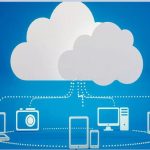Cloud computing is computing in which large groups of remote servers are networked to allow the centralized data storage, and online access to computer services or resources. Clouds can be classified as public, private or hybrid.
Cloud computing is the result of evolution and adoption of existing technologies and paradigms. The goal of cloud computing is to allow users to take benefit from all of these technologies, without the need for deep knowledge about or expertise with each one of them. The cloud aims to cut costs, and help the users focus on their core business instead of being impeded by IT obstacles.
The main enabling technology for cloud computing is virtualization. Virtualization software separates a physical computing device into one or more “virtual” devices, each of which can be easily used and managed to perform computing tasks. With operating system–level virtualization essentially creating a scalable system of multiple independent computing devices, idle computing resources can be allocated and used more efficiently. Virtualization provides the agility required to speed up IT operations, and reduces cost by increasing infrastructure utilization. Autonomic computing automates the process through which the user can provision resources on-demand. By minimizing user involvement, automation speeds up the process, reduces labor costs and reduces the possibility of human errors.
Users routinely face difficult business problems. Cloud computing adopts concepts from Service-oriented Architecture (SOA) that can help the user break these problems into services that can be integrated to provide a solution. Cloud computing provides all of its resources as services, and makes use of the well-established standards and best practices gained in the domain of SOA to allow global and easy access to cloud services in a standardized way.
Cloud computing also leverages concepts from utility computing to provide metrics for the services used. Such metrics are at the core of the public cloud pay-per-use models. In addition, measured services are an essential part of the feedback loops in autonomic computing, allowing services to scale on-demand and to perform automatic failure recovery.
Cloud computing is a kind of grid computing; it has evolved by addressing the QoS (quality of service) and reliability problems. Cloud computing provides the tools and technologies to build data/compute intensive parallel applications with much more affordable prices compared to traditional parallel computing techniques.
Grid computing -“A form of distributed and parallel computing, whereby a ‘super and virtual computer’ is composed of a cluster of networked, loosely coupled computers acting in concert to perform very large tasks.”
Mainframe computer – Powerful computers used mainly by large organizations for critical applications, typically bulk data processing such as: census; industry and consumer statistics; police and secret intelligence services; enterprise resource planning; and financial transaction processing.
Utility computing – The “packaging of computing resources, such as computation and storage, as a metered service similar to a traditional public utility, such as electricity.”
Peer-to-peer – A distributed architecture without the need for central coordination. Participants are both suppliers and consumers of resources (in contrast to the traditional client–server model).


